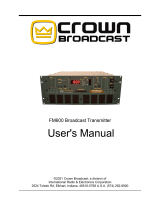
• Field analogue output adjustment:
from 50 to 130% of the U/I inputs which can be modified without
any calibrator being requested (see section: field adjustment)
• Power supply:
24VAC +10 -15%, 50 to 60Hz;
48VAC +10 -15%, 50 to 60Hz;
115VAC +10 -15%, 50 to 60Hz;
230VAC +10 -15%, 50 to 60Hz;
• Self consumption:
≤5VA (CVT-DIN AV1/AV5, CVT-DIN AV2/
AV6),
≤3VA (CVT-DIN F1/F2/F3)
• Operating temperature: from 0 to +50°C (R.H. <90% non-condensing)
• Storage temperature: from -10 to +60°C (R.H. <90% non-condensing)
• Stability of accuracy: 6 months
• Reference voltage for the insulation: 300 V
RMS to earth
• Insulation: 2000 V
RMS
between output and measuring input;
4000 V
RMS
between output and power supply input and be-
tween inputs/outputs to earth
• Dielectric strength: 4000VRMS for 1 minute
• Noise rejection (CMRR): ≥80 dB
• Connector: Screw-type, max. 2.5mm
2
wires
• Case material: ABS self-extinguishing, UL 94 V-0
• Weight: 300 g approx. (packing included)
• Degree of protection: IP 50
• Conformity to:
Safety requirements: IEC 1010-1, EN 61010-1,
Product requirements: IEC 688-1, EN 60688-1,
EMC: IEC 801-2, IEC 801-3, IEC 801-4 (level 3).
4. SWITCHING ON
Simply power the transducer.
Warning
Inside the transducer there are some calibration potentiometers that are
factory adjusted. To avoid any accuracy loss, please do not touch them.












